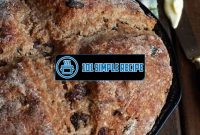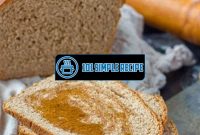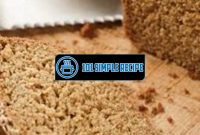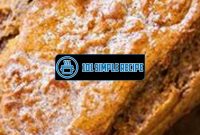Are you ready to take your baking skills to the next level? Look no further than Judy’s Homemade Brioche Recipe. This delectable treat will elevate your baking game and impress anyone who takes a bite. With its buttery and slightly sweet taste, brioche is the perfect addition to any breakfast or brunch spread. Whether you’re an experienced baker or just starting out, this recipe will guide you through the process of creating a light and fluffy brioche that melts in your mouth. So put on your apron and get ready to whip up a batch of Judy’s Homemade Brioche – you won’t be disappointed!

Understanding Brioche Bread
Brioche bread is a rich and buttery French pastry bread that is beloved by bread enthusiasts around the world. With its light and fluffy texture and irresistible taste, brioche has become a staple in bakeries and households alike. In this article, we will explore the history and characteristics of brioche bread, as well as the various delicious variations that can be created from this versatile dough.
Origins of Brioche
The origin of brioche can be traced back to France during the 17th century. It is believed to have been created in the region of Normandy, known for its quality butter. Brioche was initially enjoyed by the French aristocracy, as it was considered a luxurious treat due to its high butter content. However, over time, brioche became more accessible to the general population and gained popularity throughout the country.
Legend has it that brioche was invented by a French pastry chef named Phillipe de Meline, who was experimenting with different dough recipes. He accidentally added extra butter to his bread dough, resulting in the creation of brioche. The word “brioche” itself is derived from the Old French word “brier,” meaning to knead or mix.
Characteristics of Brioche
One of the key characteristics of brioche is its rich and tender crumb, thanks to the generous amount of butter and eggs in the dough. This gives the bread its distinctively soft and fluffy texture. Brioche is also known for its slightly sweet taste, which comes from the addition of sugar.
Another unique feature of brioche is its beautiful golden crust, achieved by brushing the dough with an egg wash before baking. This gives the bread an enticing appearance, making it even more tempting to indulge in.
Brioche is incredibly versatile and can be shaped into various forms, such as loaf pans or individual buns. It can also be used as a base for other sweet treats like cinnamon rolls or as a sandwich bread for savory fillings. The possibilities are endless with this versatile dough.
Variations of Brioche
The beauty of brioche lies in its ability to be transformed into a wide range of delicious variations. Here are a few popular ones:
- Brioche à Tête: This classic brioche is shaped into a round loaf with a smaller, round knob on top resembling a head. It is often enjoyed as a breakfast treat, perfect for pairing with a cup of hot coffee.
- Brioche Nanterre: This brioche is baked in a rectangular loaf pan, resulting in slices that are perfect for making sandwiches or toast. It is a versatile option for both sweet and savory fillings.
- Brioche Feuilletée: Also known as “puff pastry brioche,” this variation involves layering butter between sheets of brioche dough, creating a flaky and buttery texture similar to a croissant. It requires a bit more time and effort but is well worth the result.
Note: Brioche dough is highly versatile and can be adapted to include various flavors and fillings. From chocolate chips to raisins, you can customize your brioche to suit your taste preferences.
In conclusion, brioche bread is a delightful pastry that has stood the test of time. Its origins in France, along with its rich and tender texture, make it a beloved choice among baking enthusiasts. Whether you prefer a classic round loaf or a flaky puff pastry variation, brioche is sure to satisfy your cravings and elevate your baking skills to new heights. Happy baking!
The Secret Behind Judy’s Homemade Brioche Recipe
Uncover the unique aspects of Judy’s homemade brioche recipe that make it stand out from other recipes.
Special Ingredients
One of the secrets to Judy’s delicious homemade brioche is the use of special ingredients that add depth and flavor to the bread. Not only does she use high-quality flour, but she also incorporates a mixture of both butter and vegetable oil. This combination enhances the richness of the dough and creates a tender and moist texture. Judy also adds a touch of vanilla extract, which adds a subtle sweetness to the brioche. Additionally, she includes a small amount of orange zest, which adds a zing of citrus flavor that complements the other ingredients perfectly. These unique ingredients set Judy’s brioche apart from other recipes and give it a distinct and delightful taste.
Preparation Techniques
Aside from the special ingredients, Judy’s homemade brioche recipe also utilizes specific preparation techniques to ensure a perfect outcome. One key technique she employs is the use of a stand mixer with a dough hook attachment. This helps to thoroughly combine the ingredients and create a smooth and elastic dough. Judy also emphasizes the importance of allowing the dough to rise properly. She recommends placing the dough in a warm, draft-free area and covering it with a clean kitchen towel. This allows the yeast to activate and ferment, resulting in a light and airy texture. Another crucial step is the shaping of the dough. Judy suggests gently folding the dough and forming it into individual rolls or a loaf shape, depending on your preference. These preparation techniques guarantee a brioche with a soft and fluffy interior and a golden, slightly crispy crust.
Pro Tips for Success
To achieve bakery-quality results with Judy’s homemade brioche recipe, she shares a few pro tips for success. First, it’s important to measure your ingredients accurately, especially when it comes to the flour. Too much flour can make the dough dense and dry. Judy also recommends using room temperature ingredients, particularly the butter and eggs, as this ensures easy incorporation and a smoother dough. Another vital tip is to be patient during the rising process. Allowing the dough to double in size is crucial for achieving the desired texture and flavor. Finally, Judy advises brushing the brioche with an egg wash before baking. This gives the bread a beautiful golden color and adds a glossy finish. By following these pro tips, you’ll be able to elevate your baking skills and create a brioche that is truly exceptional.
Mastering the Art of Brioche Making
Whether you’re an experienced baker or just starting out, Judy’s homemade brioche recipe is sure to take your baking skills to the next level. This classic French bread is known for its rich, buttery taste and light, fluffy texture. With Judy’s step-by-step process, you’ll learn how to create the perfect brioche from start to finish, from mixing the dough to shaping and baking.
Mixing and Proofing the Dough
To begin your brioche-making journey, you’ll first need to mix and proof the dough. Start by combining warm milk, sugar, and yeast in a large mixing bowl. Allow the mixture to sit for a few minutes until the yeast becomes foamy and activates. This is an important step as it ensures that your brioche will rise properly.
Next, add in the flour and salt to the yeast mixture. Mix everything together until a sticky dough forms. It’s important not to overmix the dough at this stage, as this could result in a tough brioche.
Once the dough is well combined, it’s time to let it proof. Transfer the dough to a greased bowl, cover it with a clean kitchen towel, and let it rest in a warm place for about an hour. During this time, the yeast will continue to work its magic, causing the dough to rise and develop its characteristic flavor.
Shaping and Resting the Brioche
After the dough has finished proofing, it’s time to shape your brioche. Start by dividing the dough into equal portions, depending on the size of the brioche you want to make. You can shape the dough into traditional brioche rolls or experiment with fun shapes like a brioche loaf or individual brioche buns. The choice is yours!
Once the dough is shaped, place it on a baking sheet lined with parchment paper. Cover the dough with plastic wrap and let it rest for another hour. This resting period allows the dough to rise a bit more and develop its final texture and flavor. It’s essential not to rush this step, as it contributes to the overall quality of your brioche.
Baking and Finishing Touches
Finally, it’s time to bake your brioche and add those finishing touches. Preheat your oven to the appropriate temperature and brush the shaped brioche with an egg wash for a shiny, golden crust. You can also sprinkle some sugar or almond slices on top for added flavor and texture.
Place the brioche in the preheated oven and bake until it turns a beautiful golden brown color. The baking time will vary depending on the size and shape of your brioche, so keep a close eye on it to avoid over or under baking. Once baked, remove the brioche from the oven and let it cool on a wire rack before serving. The smell of freshly baked brioche will fill your kitchen, making it hard to resist!
With Judy’s recipe and these step-by-step instructions, you’ll be able to master the art of brioche making in no time. Give it a try and impress your family and friends with your delicious homemade brioche! Happy baking!
White Castle recipe is a delicious option if you’re looking for a unique and flavorful homemade brioche recipe.
Using Brioche in Delicious Recipes
When it comes to baking, a simple and versatile ingredient can make all the difference in elevating your dishes. Judy’s homemade brioche recipe is the perfect addition to your culinary repertoire. With its light and fluffy texture, rich flavor, and buttery aroma, brioche can take your baking skills to the next level. Let’s explore a variety of delectable dishes where brioche can truly shine, from sweet to savory.
Classic French Toast with Brioche
One of the most beloved breakfast classics, French toast, is even more indulgent when made with brioche. The rich buttery taste and airy texture of the bread create a heavenly combination when soaked in a sweet egg mixture. The result is a golden brown, crispy exterior with a soft and custardy center. Top it off with fresh berries, a drizzle of maple syrup, and a sprinkle of powdered sugar for a breakfast feast fit for royalty.
Brioche Sandwiches
Take your lunchtime sandwich game to new heights by using brioche as the bread of choice. Its light and buttery properties add an element of luxury to your favorite sandwich fillings. Whether you prefer classic ham and cheese or a gourmet combination of roasted turkey, cranberry sauce, and brie, the soft and pillowy brioche will elevate the overall taste and presentation. Don’t forget to toast the bread slightly for that perfect crunch!
Brioche Bread Pudding
Transform leftover brioche slices into a heavenly dessert with a luscious bread pudding. The buttery and slightly sweet brioche provides a wonderful base for creating a rich and creamy custard. Mix in your favorite flavors such as cinnamon, vanilla, and rum-soaked raisins for an extra touch of decadence. Serve it warm with a dollop of whipped cream or a drizzle of caramel sauce for a truly indulgent treat.
In conclusion, Judy’s homemade brioche recipe is a game-changer for any baker. Its light and fluffy texture, rich flavor, and buttery aroma add a touch of elegance to any dish. Whether you’re enjoying classic French toast, gourmet brioche sandwiches, or a heavenly bread pudding, brioche takes your cooking to a whole new level. So, what are you waiting for? Start experimenting with brioche today and discover the endless possibilities it brings to your culinary creations.
For a refreshing twist, try this punch bowl recipe to pair with your homemade brioche.
Troubleshooting and Tips for Success
Addressing common issues that can arise while making brioche and providing expert tips is essential to ensure baking success. By familiarizing yourself with potential problems and knowing how to troubleshoot them, you can confidently create delicious homemade brioche using Judy’s tried and true recipe.
Dealing with Dense Brioche
Dense brioche can be frustrating when you’re looking for a light and fluffy texture. However, with a few adjustments, you can overcome this issue and achieve the perfect consistency.
1. Allow Sufficient Proofing Time.
One of the most common reasons for dense brioche is insufficient proofing time. Proofing is when the dough is left to rise after it has been shaped. Make sure to give the dough enough time to double in size. If it hasn’t risen enough, it will result in a denser texture.
2. Use Enough Yeast.
If your brioche consistently turns out dense, you may not be using enough yeast. Yeast is responsible for the dough’s rise, so ensure you’re using the correct amount based on the recipe. Using expired yeast can also lead to dense brioche, so check the expiration date before using it.
3. Carefully Measure Ingredients.
Accurate measurements are crucial when it comes to baking. Using too much flour can make the dough dry and heavy, resulting in a dense brioche. Invest in a kitchen scale to ensure precise measurements.
Managing Overproofed Dough
Overproofed dough can lead to brioche with a gummy and collapsed texture. Save your brioche from this fate by following these tips:
1. Keep an Eye on the Clock.
When proofing, it’s important to monitor the dough’s progress to avoid overproofing. Remember to set a timer and check the dough periodically. The perfect rise should be achieved before the dough becomes overproofed.
2. Control the Proofing Environment.
The temperature and humidity of the environment can affect the proofing process. Keep your dough in a warm but not overly hot space. Avoid placing it near drafts or in direct sunlight, as they can accelerate the rise and lead to overproofing.
3. Use the Finger Test.
To determine if your dough is ready for baking, utilize the finger test. Gently press your finger into the dough, and if it springs back slowly, it’s properly proofed. If it springs back quickly or collapses, it’s likely overproofed.
Storage and Reheating Recommendations
Brioche is best enjoyed fresh, but if you have leftovers or want to prepare it in advance, proper storage and reheating are crucial to maintain its taste and texture.
1. Storage.
Wrap your brioche tightly in plastic wrap or place it in an airtight container to prevent it from drying out. Store it at room temperature for up to 2 days or in the refrigerator for up to a week.
2. Reheating.
To reheat your brioche, preheat your oven to 350°F (175°C). Place the brioche on a baking sheet and warm it for 5-10 minutes, until it reaches your desired temperature. Alternatively, you can lightly toast it in a toaster or toaster oven.
3. Freezing.
If you want to extend the shelf life of your brioche, you can freeze it. Wrap it tightly in plastic wrap and place it in a freezer-safe bag or container. When ready to enjoy, thaw it at room temperature or warm it in the oven as mentioned above.
By following these troubleshooting tips and expert advice, you can tackle any challenges that arise while making brioche and create a delightful homemade treat. Enjoy the process and take your baking skills to the next level!
Weight loss recipe can be a healthy alternative to traditional brioche if you’re watching your calorie intake.
Frequently Asked Questions
Thank you for reading our article about Judy’s Homemade Brioche Recipe! We hope you found it helpful and inspiring. If you have any questions or need further assistance, we are here to help. Please feel free to reach out to us at any time. We appreciate your support and encourage you to visit our website again for more delicious recipes and cooking tips. Happy baking!
| No. | Questions | Answers |
|---|---|---|
| 1. | Can I use instant yeast instead of active dry yeast? | Yes, you can substitute instant yeast for active dry yeast. Simply dissolve the instant yeast in warm water or milk according to the instructions and proceed with the recipe as usual. |
| 2. | Can I use bread flour instead of all-purpose flour? | Yes, you can use bread flour instead of all-purpose flour. Bread flour will give your brioche a slightly chewier texture. However, if you don’t have bread flour on hand, all-purpose flour will work just fine. |
| 3. | How long does the brioche dough need to rise? | The brioche dough should be allowed to rise for about 2 hours, or until it has doubled in size. It’s important to give the dough enough time to rise for the best texture and flavor. |
| 4. | Can I freeze the brioche dough? | Yes, you can freeze the brioche dough for later use. After the first rise, punch down the dough and shape it into a ball. Wrap it tightly in plastic wrap and place it in a freezer bag. When you’re ready to use it, thaw the dough in the refrigerator overnight and proceed with the recipe as usual. |
| 5. | Can I add raisins or chocolate chips to the brioche dough? | Absolutely! You can add raisins, chocolate chips, or any other desired mix-ins to the brioche dough. Simply fold them into the dough during the shaping process, right before the final rise. |
| 6. | How should I store the baked brioche? | Once the brioche has cooled completely, store it in an airtight container at room temperature. It will stay fresh for up to 3 days. You can also freeze any leftover brioche by wrapping it tightly in plastic wrap and placing it in a freezer bag. |
Closing Thoughts
Thank you once again for taking the time to read Judy’s Homemade Brioche Recipe. We hope you have enjoyed learning how to make this delicious and decadent bread from scratch. If you have any feedback or suggestions, we would love to hear from you. Don’t forget to visit our website regularly for more mouthwatering recipes and culinary inspiration. Happy baking and see you soon!
Jump to Recipe
Judy’s Homemade Brioche Recipe

Learn how to make Judy’s Homemade Brioche from scratch. This recipe yields deliciously fluffy and buttery brioche that is perfect for breakfast or dessert.
- 2 ¼ cups all-purpose flour
- ¼ cup granulated sugar
- 1 packet (2 ¼ teaspoons active dry yeast)
- ½ teaspoon salt
- ½ cup warm milk
- 4 large eggs
- 1 cup unsalted butter (softened)
- In a large mixing bowl, combine the flour, sugar, yeast, and salt. Mix well.
- In a separate bowl, whisk together the warm milk and 3 eggs. Pour the wet ingredients into the dry ingredients and mix until a dough forms.
- Add the softened butter to the dough, one tablespoon at a time, mixing well after each addition. Knead the dough for about 10 minutes, until it becomes smooth and elastic.
- Cover the dough with a damp cloth and let it rise in a warm place for about 2 hours, or until it has doubled in size.
- Punch down the dough and transfer it to a greased loaf pan. Cover it with the damp cloth again and let it rise for another 30 minutes.
- Preheat the oven to 375°F (190°C). Beat the remaining egg and brush it over the top of the risen dough. Bake for 25-30 minutes, until the brioche is golden brown.






